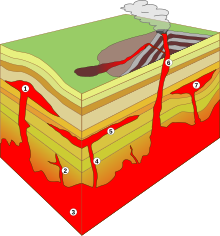Lopolith See also References Navigation menuexpanding ite
Igneous rocksPetrologyIntrusionsGeology stubs
igneousintrusionlenticularstratadikeFrank Fitch GroutDuluth gabbroMinnesotaOntariolayered intrusionsArcheanEoceneDuluth gabbroSudbury Igneous ComplexBushveld igneous complexSouth AfricaGreat DykeZimbabweSkaergaard complexNevadaimpact event
Lopolith
Jump to navigation
Jump to search

Diagram showing the shape of a lopolith (7)
A lopolith is a large igneous intrusion which is lenticular in shape with a depressed central region. Lopoliths are generally concordant with the intruded strata with dike or funnel-shaped feeder bodies below the body. The term was first defined and used by Frank Fitch Grout during the early 1900s in describing the Duluth gabbro complex in northern Minnesota and adjacent Ontario.
Lopoliths typically consist of large layered intrusions that range in age from Archean to Eocene. Examples include the Duluth gabbro, the Sudbury Igneous Complex of Ontario, the Bushveld igneous complex of South Africa, the Great Dyke in Zimbabwe, the Skaergaard complex of Greenland and the Humboldt lopolith of Nevada. The Sudbury occurrence has been attributed to an impact event and associated crustal melting.
See also
- Laccolith
References
- Blatt, Harvey and Robert J. Tracy, 1996, Petrology: Igneous, Sedimentary and Metamorphic, 2nd ed., pp. 15-16, Freeman, .mw-parser-output cite.citationfont-style:inherit.mw-parser-output .citation qquotes:"""""""'""'".mw-parser-output .citation .cs1-lock-free abackground:url("//upload.wikimedia.org/wikipedia/commons/thumb/6/65/Lock-green.svg/9px-Lock-green.svg.png")no-repeat;background-position:right .1em center.mw-parser-output .citation .cs1-lock-limited a,.mw-parser-output .citation .cs1-lock-registration abackground:url("//upload.wikimedia.org/wikipedia/commons/thumb/d/d6/Lock-gray-alt-2.svg/9px-Lock-gray-alt-2.svg.png")no-repeat;background-position:right .1em center.mw-parser-output .citation .cs1-lock-subscription abackground:url("//upload.wikimedia.org/wikipedia/commons/thumb/a/aa/Lock-red-alt-2.svg/9px-Lock-red-alt-2.svg.png")no-repeat;background-position:right .1em center.mw-parser-output .cs1-subscription,.mw-parser-output .cs1-registrationcolor:#555.mw-parser-output .cs1-subscription span,.mw-parser-output .cs1-registration spanborder-bottom:1px dotted;cursor:help.mw-parser-output .cs1-ws-icon abackground:url("//upload.wikimedia.org/wikipedia/commons/thumb/4/4c/Wikisource-logo.svg/12px-Wikisource-logo.svg.png")no-repeat;background-position:right .1em center.mw-parser-output code.cs1-codecolor:inherit;background:inherit;border:inherit;padding:inherit.mw-parser-output .cs1-hidden-errordisplay:none;font-size:100%.mw-parser-output .cs1-visible-errorfont-size:100%.mw-parser-output .cs1-maintdisplay:none;color:#33aa33;margin-left:0.3em.mw-parser-output .cs1-subscription,.mw-parser-output .cs1-registration,.mw-parser-output .cs1-formatfont-size:95%.mw-parser-output .cs1-kern-left,.mw-parser-output .cs1-kern-wl-leftpadding-left:0.2em.mw-parser-output .cs1-kern-right,.mw-parser-output .cs1-kern-wl-rightpadding-right:0.2em
ISBN 0-7167-2438-3 - Guilbert, John M., and Park, Charles F., Jr. (1986) The Geology of Ore Deposits, Freeman,
ISBN 0-7167-1456-6
This geology article is a stub. You can help Wikipedia by expanding it. |
Categories:
- Igneous rocks
- Petrology
- Intrusions
- Geology stubs
(RLQ=window.RLQ||[]).push(function()mw.config.set("wgPageParseReport":"limitreport":"cputime":"0.076","walltime":"0.112","ppvisitednodes":"value":412,"limit":1000000,"ppgeneratednodes":"value":0,"limit":1500000,"postexpandincludesize":"value":4840,"limit":2097152,"templateargumentsize":"value":876,"limit":2097152,"expansiondepth":"value":12,"limit":40,"expensivefunctioncount":"value":0,"limit":500,"unstrip-depth":"value":0,"limit":20,"unstrip-size":"value":3744,"limit":5000000,"entityaccesscount":"value":0,"limit":400,"timingprofile":["100.00% 92.605 1 -total"," 83.56% 77.383 2 Template:ISBN"," 54.79% 50.742 2 Template:Catalog_lookup_link"," 16.33% 15.125 1 Template:Geology-stub"," 12.69% 11.750 1 Template:Asbox"," 10.57% 9.792 2 Template:Error-small"," 8.10% 7.504 2 Template:Small"," 5.76% 5.331 6 Template:Yesno-no"," 3.48% 3.223 6 Template:Yesno"," 2.73% 2.531 4 Template:Trim"],"scribunto":"limitreport-timeusage":"value":"0.014","limit":"10.000","limitreport-memusage":"value":1081323,"limit":52428800,"cachereport":"origin":"mw1266","timestamp":"20190514154313","ttl":2592000,"transientcontent":false););"@context":"https://schema.org","@type":"Article","name":"Lopolith","url":"https://en.wikipedia.org/wiki/Lopolith","sameAs":"http://www.wikidata.org/entity/Q1869822","mainEntity":"http://www.wikidata.org/entity/Q1869822","author":"@type":"Organization","name":"Contributors to Wikimedia projects","publisher":"@type":"Organization","name":"Wikimedia Foundation, Inc.","logo":"@type":"ImageObject","url":"https://www.wikimedia.org/static/images/wmf-hor-googpub.png","datePublished":"2007-01-27T03:04:35Z","dateModified":"2018-04-05T09:05:18Z","image":"https://upload.wikimedia.org/wikipedia/commons/6/66/Intrusion_types.svg","headline":"lenticular igneous intrusion with a depressed central region"(RLQ=window.RLQ||[]).push(function()mw.config.set("wgBackendResponseTime":119,"wgHostname":"mw1270"););